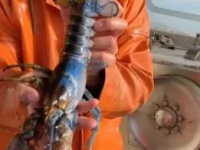Evacuations underway in Iceland as possible volcanic eruption looms
Author of the article:Washington Post
Washington Post
Matthew Cappucci, The Washington Post
Published Nov 10, 2023 • 3 minute read
A barrage of hundreds of earthquakes, including two exceeding a magnitude of 5.0 and at least seven topping 4.5, rattled Iceland’s Reykjanes Peninsula on Friday. The seismic swarm suggests the eruption of an area volcano in the hours or day ahead and has prompted the Icelandic Meteorological Office to declare a Civil Protection Emergency Level.
The Fagradalsfjall volcano is in Iceland’s southern peninsula region, about 25 miles southwest of Reykjavik, the country’s capital. A number of tremors have shaken the city, and the famed Blue Lagoon geothermal spa in Grindavik has been closed. It was initially unclear whether Fagradalsfjall was responsible for the increased seismic activity or whether an eruption was brewing elsewhere within the Reykjanes volcanic system.
Shortly before midnight local time, all of Grindavik was asked to evacuate. At 11:30 p.m. local time, the Meteorological Office warned that volcanic fissures could open near or within the town.
“Based on how the seismic activity has evolved since 6 PM today, along with results from GPS measurements, there is a likelihood that a magma intrusion has extended beneath Grindavík,” the office wrote.
Experts believe that a magmatic dike may have formed directly below the town. Dikes are sheets of magma that flow through existing fractures in rock or generate a new crack. The largest volcanoes may contain hundreds of dikes.
A Code Orange – or a Level 3 out of 4 on the universal ground-based volcano alerting scale – has been declared, raising concerns at Keflavik International Airport, which sits just northwest of the seismically active region.
The region has experienced intermittent eruptions since 2021, yet the incipient eruption will probably be markedly more intense.
“The amount of magma involved is significantly more than what was observed in the largest magma intrusions associated with the eruptions at Fagradalsfjall,” the Meteorological Office said.
The office had warned Friday afternoon that earthquakes were located about two miles northeast of Grindavik, with the fault slips occurring about two to three miles below the ground. Earthquakes crept toward the community of 3,300 around sunset.
“The seismic activity has moved south towards Grindavík,” the Meteorological Office said.
“The signs that can be seen now … are similar to those seen on the eve of the first eruption at Fagradalsfjall in 2021, and are very similar to the seismic activity that was measured about a month before that eruption,” the office had cautioned in an earlier update. It had previously estimated that it would take several days for magma to reach the surface and the imminent eruption to begin.
Already, the quaking has ruptured roadways. It appears that up to three inches of uplift, or vertical movement of the ground, has occurred near the volcano.
A total of 295 earthquakes of magnitude 3.0 or greater had been detected in the previous 72 hours, with upward of 90% of those occurring in the past day.
While Iceland is tectonically and volcanically active, the region around the Fagradalsfjall volcano had lain dormant for over 6,300 years until December 2019. That’s when a flurry of earthquakes, including two that reached magnitude 5.6, rattled the peninsula. Then on Feb. 4, 2021, a magnitude-5.7 earthquake caused minor damage to homes. Six weeks later, on March 19, the volcano erupted, with a roughly 2,000-foot-long fissure started spewing lava.
The fissure was later named Geldingadalsgos, representing a possible new shield volcano – a broad volcano with gently sloping sides – and it attracted widespread tourism. Several other fissures opened in April, but only one remained active in May 2021. Another eruption from a separate fissure of Fagradalsfjall took place on Aug. 3, 2022.
Then this past summer, in early July, a new eruption began near Litli-Hrutur, also part of the Fagradalsfjall volcano. It was about 10 times as big as the first two eruptions. It diminished by Aug. 5.

 torontosun.com
torontosun.com
Author of the article:Washington Post
Washington Post
Matthew Cappucci, The Washington Post
Published Nov 10, 2023 • 3 minute read
A barrage of hundreds of earthquakes, including two exceeding a magnitude of 5.0 and at least seven topping 4.5, rattled Iceland’s Reykjanes Peninsula on Friday. The seismic swarm suggests the eruption of an area volcano in the hours or day ahead and has prompted the Icelandic Meteorological Office to declare a Civil Protection Emergency Level.
The Fagradalsfjall volcano is in Iceland’s southern peninsula region, about 25 miles southwest of Reykjavik, the country’s capital. A number of tremors have shaken the city, and the famed Blue Lagoon geothermal spa in Grindavik has been closed. It was initially unclear whether Fagradalsfjall was responsible for the increased seismic activity or whether an eruption was brewing elsewhere within the Reykjanes volcanic system.
Shortly before midnight local time, all of Grindavik was asked to evacuate. At 11:30 p.m. local time, the Meteorological Office warned that volcanic fissures could open near or within the town.
“Based on how the seismic activity has evolved since 6 PM today, along with results from GPS measurements, there is a likelihood that a magma intrusion has extended beneath Grindavík,” the office wrote.
Experts believe that a magmatic dike may have formed directly below the town. Dikes are sheets of magma that flow through existing fractures in rock or generate a new crack. The largest volcanoes may contain hundreds of dikes.
A Code Orange – or a Level 3 out of 4 on the universal ground-based volcano alerting scale – has been declared, raising concerns at Keflavik International Airport, which sits just northwest of the seismically active region.
The region has experienced intermittent eruptions since 2021, yet the incipient eruption will probably be markedly more intense.
“The amount of magma involved is significantly more than what was observed in the largest magma intrusions associated with the eruptions at Fagradalsfjall,” the Meteorological Office said.
The office had warned Friday afternoon that earthquakes were located about two miles northeast of Grindavik, with the fault slips occurring about two to three miles below the ground. Earthquakes crept toward the community of 3,300 around sunset.
“The seismic activity has moved south towards Grindavík,” the Meteorological Office said.
“The signs that can be seen now … are similar to those seen on the eve of the first eruption at Fagradalsfjall in 2021, and are very similar to the seismic activity that was measured about a month before that eruption,” the office had cautioned in an earlier update. It had previously estimated that it would take several days for magma to reach the surface and the imminent eruption to begin.
Already, the quaking has ruptured roadways. It appears that up to three inches of uplift, or vertical movement of the ground, has occurred near the volcano.
A total of 295 earthquakes of magnitude 3.0 or greater had been detected in the previous 72 hours, with upward of 90% of those occurring in the past day.
While Iceland is tectonically and volcanically active, the region around the Fagradalsfjall volcano had lain dormant for over 6,300 years until December 2019. That’s when a flurry of earthquakes, including two that reached magnitude 5.6, rattled the peninsula. Then on Feb. 4, 2021, a magnitude-5.7 earthquake caused minor damage to homes. Six weeks later, on March 19, the volcano erupted, with a roughly 2,000-foot-long fissure started spewing lava.
The fissure was later named Geldingadalsgos, representing a possible new shield volcano – a broad volcano with gently sloping sides – and it attracted widespread tourism. Several other fissures opened in April, but only one remained active in May 2021. Another eruption from a separate fissure of Fagradalsfjall took place on Aug. 3, 2022.
Then this past summer, in early July, a new eruption began near Litli-Hrutur, also part of the Fagradalsfjall volcano. It was about 10 times as big as the first two eruptions. It diminished by Aug. 5.

Evacuations underway in Iceland as possible volcanic eruption looms
A barrage of hundreds of earthquakes, including two exceeding a magnitude of 5.0, rattled Iceland's Reykjanes Peninsula on Friday.











![coho-death-bc-20231119[1].jpg coho-death-bc-20231119[1].jpg](https://forums.canadiancontent.net/data/attachments/18/18339-8ef744c21e44c58cfe07356ee4b53e56.jpg)






